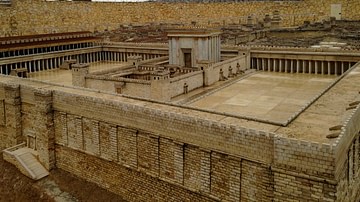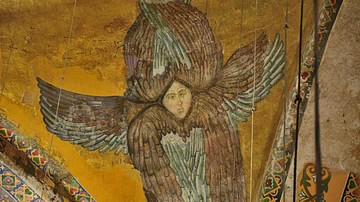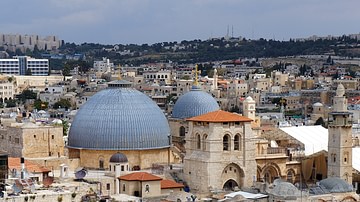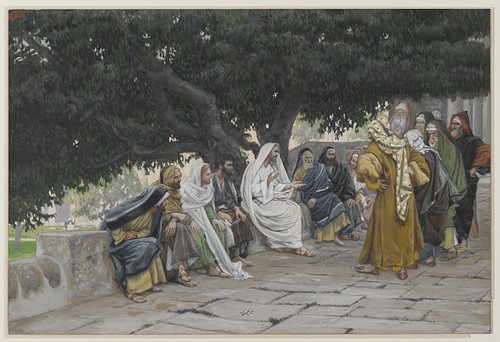
The Sadducees were part of the upper-class aristocrats and provided much of the priesthood, categorized through the lineage of priestly houses. They served on the Sanhedrin, the city council that organized law courts and regulations, which were established throughout Israel. The Sadducees were a distinct sect of Judaism from roughly 200-150 BCE to 70 CE, when the Temple complex in Jerusalem was destroyed by Rome.
The name Sadducee most likely derives from Zadok, the first high priest to serve in Solomon's Temple before its destruction by the Babylonians in 587/586 BCE. The root form means "to be right, just." When Cyrus II (r. c. 550-530 BCE), founder of the Persian Achaemenid Empire, conquered the Babylonians, he permitted the captive Jews to return to Jerusalem to rebuild their Temple (539 BCE). Cyrus the Great ruled over hundreds of native cults and permitted them to practice their ancestral traditions. However, his rule was done through local Persian governors, the satraps; there was no longer a king in Israel. In the absence of a king, this period saw the dominance of the high priest and the Temple priests taking charge of the civic organization of towns and cities. This theocracy became the center of religious as well as political leadership.
The Responsibilities of the Sadducees
The Sadducees were responsible for the maintenance of the Temple cultus, or all the elements of Temple worship. Their main function was to preside over the sacrifices, which were conducted at the large altar inside the Temple complex. There were living quarters for priests in the complex as well. They organized the three major Jewish religious pilgrimage festivals, Passover, Shavuot (Weeks), and Sukkot (Tabernacles). Priests rotated in serving in the Temple.
The position of the high priest was enhanced because he was the only one who was permitted to enter the Holy of Holies, the inner sanctum of the Temple, on Yom Kippur (the Day of Atonement). On that day he performed the ceremony of the two goats. One was sacrificed and the other was sent into the wilderness and given to Azazel. The meaning of Azazel remains unknown but could indicate either a demon or simply a region of the desert. The purpose of this ceremony was to achieve collective atonement (a covering up of sins) for the people, as "The goat will carry on itself all their sins to a remote place; and the man shall release it in the wilderness" (Leviticus 16:22).
In what we would deem their civic responsibilities, the Sadducees represented the state in international negotiations, collected taxes, equipped and led armies, and served as judges in domestic law courts. With the Roman conquest of Jerusalem by Pompey the Great (106-48 BCE) in 63 BCE, the Sadducees worked in concert with both magistrates of the Roman government and the local Roman client-kings, the Herodians. What concerned the Sadducees the most was never allowing Rome an excuse to close the Temple. This provided oppositional criticism by other Jewish sects that the Sadducees were collaborators with the enemy.
Theology of the Sadducees
The sources for the Sadducees are some references in the Dead Sea Scrolls (the Essenes), the writings of the 1st-century CE Jewish historian Flavius Josephus (36-100 CE), the New Testament, and the writings of 2nd-century CE rabbis. All of these sources are historically problematic because no literature from the Sadducees survived the destruction of the Second Temple by Rome. It is difficult to obtain a clear picture because all of these sources were written by opponents who were critical of the Sadducees and the way in which they were operating the Temple.
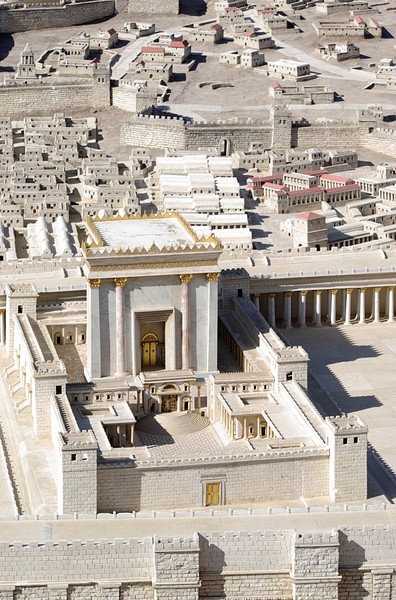
Sadducees held to a more traditional anthropomorphic concept of God, rejecting the Hellenistic influence of an abstract, pure essence. They opposed the Pharisees' claim of an oral law that had been also passed down by Moses. For the Sadducees, what is contained solely in the written Law of Moses was viable. Humans were created with free will to choose good or evil. According to the Acts of the Apostles, the Sadducees denied the existence or influence of angels. In relation to salvation, only the Temple rituals were of benefit. They denied the resurrection of the dead. They did not believe in the immortality of the soul; there was no afterlife. Instead of rewards and punishments after death, all the dead reside in Sheol, the Jewish place of the dead.
Sadducees in the New Testament
Modern understanding of the Sadducees is drawn from their portraits in the gospels. Like the Pharisees, the Sadducees play the oppositional foil for the teachings of Jesus of Nazareth. They are often depicted in scenes where they challenge Jesus with trick questions to find reasons to accuse him of violating Mosaic Law.
The template for the view that the Sadducees were corrupt officials of the Temple stems from the scene known as the Temple Incident in Mark's gospel. Jesus drove out the animal-sellers and overturned the tables of the money-changers, citing a combined quote from Isaiah and Jeremiah: "Is it not written: 'My house will be called a house of prayer for all nations?' But you have made it a 'den of robbers'" (Mark 11:17).
All ancient people charged a fee for sacrificial animals. Where this temple differed from others was the presence of the money-changers. Jews banned images, but coins carried in purses had images of the Roman emperor and sometimes gods. A fee was charged for this exchange.
Outside of Mark, we have no evidence that either the animal-sellers or the money-changers were cheating people. This conviction comes from the reference to a "den of robbers" or "den of thieves," depending on the translation. However, a "den of thieves" does not mean stealing; it is a safe haven where they distribute the loot. Both Isaiah and Jeremiah criticized Jews for the assumption that the Temple was a safe haven where they could perform the sacrifices, thinking that would save them from the coming judgment. Without true repentance, the sacrifices meant nothing, but neither Isaiah nor Jeremiah ever suggested that the sacrifices and rituals should stop.
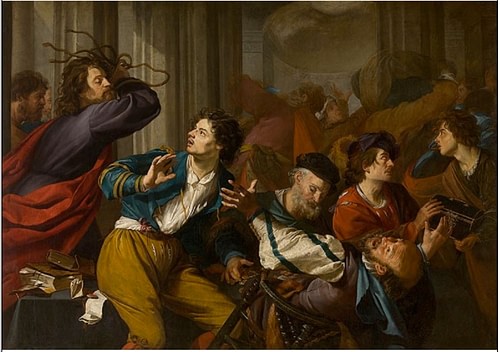
Mark's word for "thieves" is lestes, Greek for "bandits." This may have been his reference to the Zealots who roamed as bandits, attacking Roman convoys. The Zealots eventually seized the Temple and slaughtered many of the priests, resulting in the Great Jewish Revolt of 66 CE against Rome.
Mark (followed by Matthew, Luke, and John) claimed that it was this incident that led to the trial and crucifixion of Jesus of Nazareth. At the same time, the story was presented as a rationale for why God permitted Rome to destroy the Temple in 70 CE because of corrupt practices.
Prominent Sadducees
The sources for prominent Sadducees during the 1st century CE are found in the works of the Jewish historian Flavius Josephus and the New Testament. Joseph ben Caiaphas is notable for presiding over the Sanhedrin trial of Jesus. He was the son-in-law of a former high priest, Annas (in office 6-15 CE). Mark, Matthew, and Luke have the trial before Caiaphas, but the Gospel of John claimed that Jesus was taken first to the house of Annas, and then to Caiaphas. Caiaphas took center stage when he asked Jesus:
"Are you the Messiah, the Son of the Blessed One?" "I am," said Jesus. "And you will see the Son of Man sitting at the right hand of the Mighty One and coming on the clouds of heaven." The high priest tore his clothes. "Why do we need any more witnesses?" he asked. "You have heard the blasphemy. What do you think?" They all condemned him as worthy of death. (Mark 14:61-64).
Mark presented Caiaphas as a liar; claiming to be the messiah in Judaism was not blasphemy. John's gospel related the story that the Sanhedrin was worried about the crowds following Jesus after the raising of Lazarus:
"Here is this man performing many signs. If we let him go on like this, everyone will believe in him, and then the Romans will come and take away both our temple and our nation." Then one of them, named Caiaphas, who was high priest that year, spoke up, "You know nothing at all! You do not realize that it is better for you that one man die for the people than that the whole nation perish." ... So from that day on they plotted to take his life. (John 11:47-53).
In the Acts of the Apostles, Peter and John appear before Annas and Caiaphas after they healed a cripple in the name of Jesus. When questioned how the Apostles have such authority, Peter (full of the holy spirit) claimed that Jesus was the source of their power. Peter and John were ordered to stop doing this, but Peter replied: "Which is right in God's eyes: to listen to you, or to him? You be the judges! As for us, we cannot help speaking about what we have seen and heard" (Acts 4:19-20).
In The Antiquities of the Jews (Book 20, 9.1), Josephus told the story of the stoning of James, the brother of Jesus. The high priest Ananus ben Ananus ordered his death for violations of Mosaic Law, but without detail. He lost his position because he had acted before the arrival of the new Roman procurator.
In 1990, workers found a limestone ossuary (bone box) in the Jerusalem neighborhood of Abu Tor. An Aramaic inscription on the side reads: "Joseph, son of Caiaphas." The bone fragments are of an elderly man of the period. However, some scholars doubt the relationship, as there is no mention of the title high priest, the spelling is debated, and it is not the ossuary of an aristocrat.




